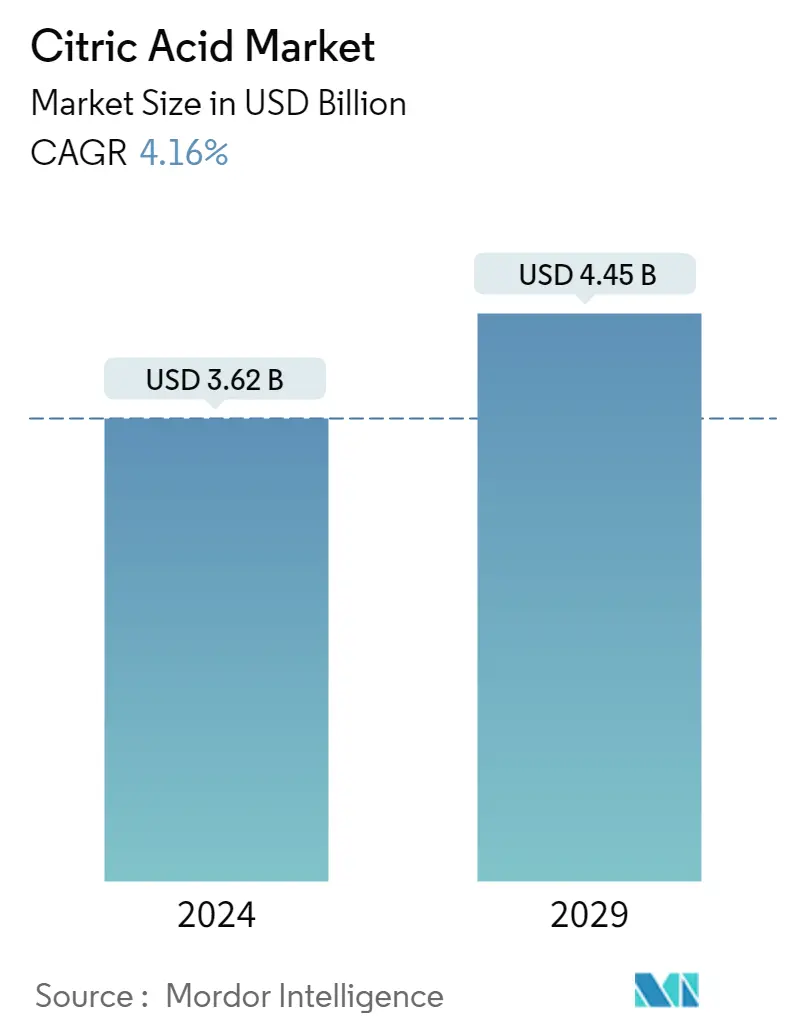Market Size of Citric Acid Industry

| Study Period | 2019 - 2029 |
| Market Size (2024) | USD 3.62 Billion |
| Market Size (2029) | USD 4.45 Billion |
| CAGR (2024 - 2029) | 4.16 % |
| Fastest Growing Market | Asia Pacific |
| Largest Market | Asia-Pacific |
Major Players.webp)
*Disclaimer: Major Players sorted in no particular order |
Citric Acid Market Analysis
The Citric Acid Market size is estimated at USD 3.62 billion in 2024, and is expected to reach USD 4.45 billion by 2029, growing at a CAGR of 4.16% during the forecast period (2024-2029).
- The versatile nature of citric acid makes it a valuable component in various industries, including food and non-food sectors. It is utilized as an acidulant, preservative, antioxidant, buffering, and binding agent. The applications of citric acid, in both liquid and anhydrous forms, span across different domains, such as food and beverages, pharmaceuticals, personal care, and more. In food products, citric acid is added as an additive to intensify sourness, tartness, and flavor. Moreover, its inclusion suppresses microbial growth, thereby increasing the shelf life of food products and driving the demand for citric acid.
- The popularity of citric acid in medicines and dietary supplements is on the rise globally. Its use helps preserve and stabilize the active ingredients in medicines and can also enhance the taste of chewable and syrup-based medications. Citric acid is also known to boost the absorption of mineral supplements like magnesium and calcium.
- Moreover, consumers are increasingly demanding citric acid extraction from natural sources as they prefer vegan sources for their products. This trend has led market players to focus on continuously launching new products with improved application capabilities and high-quality standards. As a result, the market for citric acid is expected to grow significantly in the coming years.
Citric Acid Industry Segmentation
Citric acid is a weak organic acid naturally found in several citrus fruits such as lemons, limes, etc.
The citric acid market is segmented by form, application, and geography. By form, the market is segmented into liquid and anhydrous. By application, it is segmented into food and beverage, pharmaceuticals, personal care, and other applications. The food and beverage segment is further sub-segmented into the bakery, confectionery, dairy drinks, and other foods and beverages. By geography, the market studied is segmented into North America, South America, Europe, Asia Pacific, the Middle East, and Africa.
For each segment, the market sizing and forecasts have been done based on value (in USD).
| Form | |
| Liquid | |
| Anhydrous |
| Application | |||||||
| |||||||
| Pharmaceutical | |||||||
| Personal Care | |||||||
| Other Applications |
| Geography | |||||||||
| |||||||||
| |||||||||
| |||||||||
| |||||||||
|
Citric Acid Market Size Summary
The citric acid market is poised for significant growth, driven by its versatile applications across various industries, including food, pharmaceuticals, and personal care. As an essential ingredient, citric acid serves multiple functions such as acidulant, preservative, and antioxidant, enhancing the flavor and shelf life of food products. The increasing demand for natural and vegan sources of citric acid is shaping market dynamics, with consumers preferring products with clean labels and natural ingredients. This trend is further supported by regulatory bodies advocating for the reduction of synthetic additives due to health concerns, prompting manufacturers to innovate and offer high-quality, naturally sourced citric acid products.
China and Japan are key players in the citric acid market, with China being a major producer and exporter, while Japan's demand for naturally sourced citric acid is driven by its culinary preferences and health-conscious consumer base. The competitive landscape is characterized by the presence of major companies like Archer Daniels Midland, Cargill Incorporated, and Jungbunzlauer, which are focusing on product innovation and expansion to meet global demand. These companies are investing in research and development to enhance product quality and sustainability, ensuring they remain competitive in a fragmented market. The ongoing expansion of production facilities, such as Jungbunzlauer's plant in Canada, underscores the industry's commitment to meeting the growing needs of diverse sectors.
Citric Acid Market Size - Table of Contents
-
1. MARKET DYNAMICS
-
1.1 Market Drivers
-
1.2 Market Restraints
-
1.3 Porter's Five Forces Analysis
-
1.3.1 Threat of New Entrants
-
1.3.2 Bargaining Power of Buyers/Consumers
-
1.3.3 Bargaining Power of Suppliers
-
1.3.4 Threat of Substitute Products
-
1.3.5 Intensity of Competitive Rivalry
-
-
-
2. MARKET SEGMENTATION
-
2.1 Form
-
2.1.1 Liquid
-
2.1.2 Anhydrous
-
-
2.2 Application
-
2.2.1 Food and Beverage
-
2.2.1.1 Bakery
-
2.2.1.2 Confectionery
-
2.2.1.3 Dairy
-
2.2.1.4 Beverages
-
2.2.1.5 Other Foods and Beverages
-
-
2.2.2 Pharmaceutical
-
2.2.3 Personal Care
-
2.2.4 Other Applications
-
-
2.3 Geography
-
2.3.1 North America
-
2.3.1.1 United States
-
2.3.1.2 Canada
-
2.3.1.3 Mexico
-
2.3.1.4 Rest of North America
-
-
2.3.2 Europe
-
2.3.2.1 Germany
-
2.3.2.2 United Kingdom
-
2.3.2.3 France
-
2.3.2.4 Russia
-
2.3.2.5 Spain
-
2.3.2.6 Italy
-
2.3.2.7 Rest of Europe
-
-
2.3.3 Asia-Pacific
-
2.3.3.1 India
-
2.3.3.2 China
-
2.3.3.3 Japan
-
2.3.3.4 Australia
-
2.3.3.5 Rest of Asia-Pacific
-
-
2.3.4 South America
-
2.3.4.1 Brazil
-
2.3.4.2 Argentina
-
2.3.4.3 Rest of South America
-
-
2.3.5 Middle-East and Africa
-
2.3.5.1 South Africa
-
2.3.5.2 United Arab Emirates
-
2.3.5.3 Rest of Middle-East and Africa
-
-
-
Citric Acid Market Size FAQs
How big is the Citric Acid Market?
The Citric Acid Market size is expected to reach USD 3.62 billion in 2024 and grow at a CAGR of 4.16% to reach USD 4.45 billion by 2029.
What is the current Citric Acid Market size?
In 2024, the Citric Acid Market size is expected to reach USD 3.62 billion.

